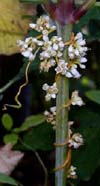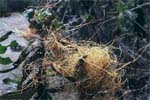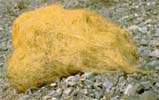Back to Don's Maps
Back to the index of plants and animals
Golden Thread - formerly used as a herbal contraceptive and abortifacient
Goldenthread is a Cuscuta species, and is sometimes called Goldthread. Cuscuta is parasitic and strangles the plant it lives on.

American Indians seem to have harvested the plant while it was in flower, taking the whole plant. They used the plants in a bath for the treatment of tuberculosis. Early settlers, probably taking cues from the natives, put fevered children in a similar bath. It's unclear if this did much good. Indians also thought the plant a useful contraceptive.
Photo: http://www.main.nc.us/naturenotebook/plants/dodder.html
 The following text is from:
The following text is from:
http://bernard.pitzer.edu/~mmaldona/luce/tongva/dodder.htm
Dodder is a parasitic plant that the Tongva use as medicine in many different forms. Dodder is used to relieve asthma. The stems of the plant are boiled to produce a steam, which is then inhaled by the asthma sufferer. Ahiko is also good for nosebleeds. Fresh dodder stems are collected and crushed to make a juice. This juice is then mixed with the powder of dried dodder stems, which the patient inhales through the nostrils.
The Tongva (a native American Indian group) also use dodder as an emetic, brewing the stems and then drinking the compound to induce vomiting. The whole plant can even be eaten for use as a contraceptive. Finally, they use a special type of dodder for treating spider bites. This type of dodder only grows on buckwheat, and the Tongva gather and brew the plant into a tea to apply to the bites.
The Tongva consider dodder a very powerful plant, and its effects may be very dangerous if the amount used is not monitored closely. Too much dodder can lead to exaggerated vomiting and even death.

Cuscuta californica
Here dodder has completely covered the host plant it is parasitic on.
Photo: http://www.botgard.ucla.edu/html/botanytextbooks/lifeforms/parasiticplants/a0224tx.html
Text below from: http://www.storysite.org/story/whatdowemeanbysex.html
A more common trigger for gynaecomastia appears to be exposure to plants that produce copious amounts of phytosteroids, possessing oestrogenic properties. The best-known such plant is the so-called Madagascar periwinkle (Lochnera species), which today is cultivated as a source of the raw material from which contraceptive pills are manufactured. It is not restricted to Madagascar, but widely distributed throughout central Africa.
In many African languages its vernacular name may be translated as widow wort, and only widows (or women past the menopause, the older meaning of the word 'widow') may collect it for use in tribal medicine. Its abortifacient properties are well-known to the local people. In a man, repeated ingestion of widow wort, or even the use of the plant as a poultice, will induce impotence, shrinkage of the testes, and gynaecomastia, as a result of the high levels of phytosteroids.
Widowwort (spelled as a single word) is an older English name for the parasitic plant dodder (Cuscuta species), whose golden threads were used at one time as a contraceptive and as an abortifacient. Under the name "golden threads" it figures in this capacity in Jean Auel's series of novels about Pleistocene life. In many languages from different parts of the world plants containing phytosteroids with contraceptive and oestrogenic properties may only be gathered by widows or by women past menopause, and are called by names that may be translated as widow's plant, or widow wort.
From:
http://www.ijp-online.com/archives/1995/027/04/r0227-0229ra.pdf
Genus cuscuta (Dodder, vernacular names: Hindi-Amarbel,
Akasbel) have more than 150 species.
They belong to family Cuscutaceae a division of
Convolvulaceae. These leafless parasite plants
have yellow or orange thread like stem. They spread
around trees and shrubs and draw their nourishment
from them.
Species are widely distributed throughout
India ascending the Himalayas up to an altitude of
8 000 feet and also in other parts of the world. The
stem contain cuscutin (c1sH120s,m.p.208-9 deg) and
the seeds contain pigment amarbelin a flavone
(ClsH1s07,m.p.234 deg) and cuscutin. This parasite
plant is without chlorophyll.
The stem has been
used as purgative, in protracted fever, bilious disorders,
induration of liver, abortifacient and in
melancholia. Externally it has been used for itch
and washing sores. The seeds have been used
as carminative, purgative and as an anodyne.